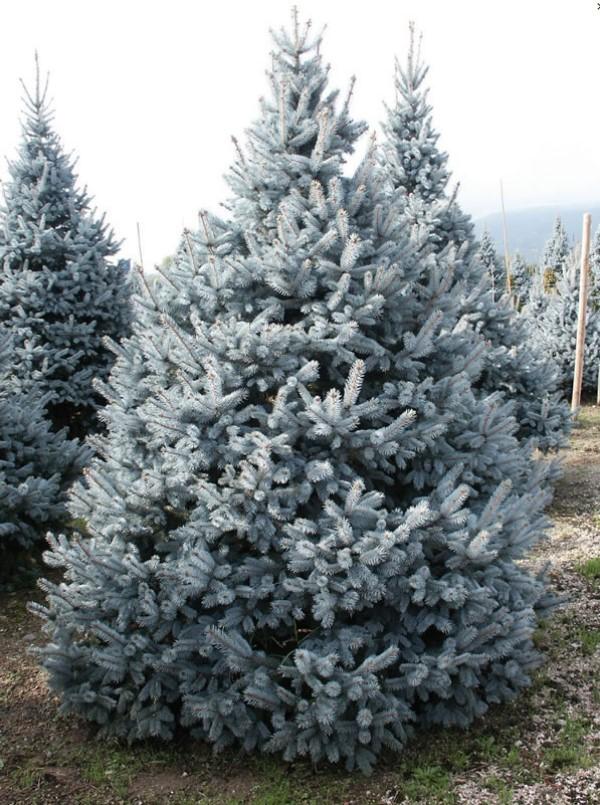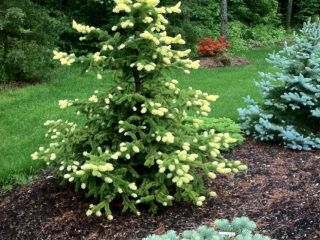Content
Prickly spruces are common in the northern part of America, sometimes they are also called Colorado spruces. The plant can be recognized by its beautiful bluish crown, which was once noticed by breeders. Spruce Koster is a frost-resistant variety that differs from ordinary spruce not only in shape, but also in size.
Origin story

Spruce is often planted to improve areas
Little is known about the biography of the plant. It was probably discovered long before official confirmation. The species was recorded in 1901 by the Dutchman Ari Coster, after whom it received its name. The originator of the variety conducted research in a nursery in the city of Boskop.
However, it was not Koster who brought out the spruce, which can be seen from earlier mentions in literary works. Found trade records indicate that the species appeared before 1800. It is known that over several centuries the variety has become one of the most recognizable. Due to its characteristic blue hue and crown shape, it is used in landscape design. Fir trees are accompanied by many monuments.
Description of blue spruce Bonfire
The variety has a geometrically regular cone shape.The needles are blue. Depending on the conditions and place of growth, it may have a blue or dark tint. The branches are strong enough to withstand strong winds, so the plant does well in open areas.
The needles are hard and sharp, reaching 3 cm in length. With age, they gradually bend, and from the outside they resemble a shoe needle. The needles are located very densely, preventing even small animals from approaching the trunk. In early spring, the Bonfire becomes overgrown with cones, which can be purple, green, blue or red. The fruits reach 11 cm in size and grow densely. Due to their large dimensions they hang down. With age, like most conifers, the cones turn brown.
Spruce is resistant to harmful gases and tolerates temperature changes well. The plant requires virtually no care. It takes the necessary substances from the soil. If the land is infertile, the soil must be fertilized periodically. Grows in temperate climates, prefers moist areas. Can be pruned, especially if used for decorative purposes.

Bonfire attracts gardeners all over the world with its luxurious blue crown
Ephedra prefers to grow in open areas with access to sunlight. Upon contact with them, the spruce becomes bluer. It can grow in the shade, for example, when planted densely to improve large areas. Sometimes the Koster variety is used as a New Year's tree. Due to its pleasant smell, the seedling is placed indoors to improve the aroma.
Spruce height Bonfire
Growth rates are average. Under favorable conditions, spruce adds up to 25 cm per year. At the age of seven it already exceeds human height, and at the age of 10 it reaches three meters.Adult specimens grow up to 16 m. The crown is quite voluminous, accounting for approximately a third of the total height.
Due to the characteristics of the branches at an early age, the lower part sprouts faster. For this reason, the plant may appear asymmetrical.
Frost resistance
The variety is notable for its resistance to external influences. Strong branches calmly hold snowdrifts. Bonfire is one of the most frost-resistant species. This allows it to be used to improve the northern regions. The plant can withstand temperatures down to -42 °C. When planting in hot climates, it requires frequent watering and periodic irrigation.
Advantages and disadvantages
The luxurious appearance of spruce allows it to be used in ornamental gardening. It is planted in gardens and dachas.

Spruce can be found in alleys, memorial places and private homes
Pros:
- frost resistance;
- nice smell;
- moderate growth;
- unpretentiousness;
- resistance to harmful gases.
Minuses:
- at an early age, the spruce does not look so beautiful.
When planting in a hot environment, be aware that the brome will grow more slowly.
Landing Features
Planting is carried out in spring or early autumn. Loamy soil will be optimal for spruce.
Planting pattern:
- Dig a spacious hole maintaining a distance of 2.5 m from other plants.
- For drainage, crushed stone or small stones are placed at the bottom.
- The seedling is placed and buried in soil with a previously prepared substrate (usually sand and peat are used).
- The young spruce is watered abundantly and the soil is thoroughly loosened.
Care instructions
Young spruce can be pruned, but it is not recommended to remove healthy branches. Only dry pine needles are removed. Watering is carried out in small portions 3-4 times a day. Upon reaching one year, it is reduced to once. Up to five years the plant must be fed. If the area is susceptible to attack by pests, Decis treatment is used.
Reproduction

The easiest way to propagate Bonfire is by seedlings.
Cuttings and use of seeds are allowed. In the latter case, to reach the size of the seedling, it is necessary to care for the plant for about three years. The seeds are collected in winter, soaked in potassium permanganate, and placed in a container with soil. Place in the refrigerator until spring. Then the container is taken out, covered with a bottle and watered.
Diseases and pests
When the Koster variety grows in favorable conditions, its immunity increases. Diseases and pests do not cause much harm. Natural pests of the Bonfire spruce are:
- scale insect;
- mite;
- aphid.

A common disease that is accompanied by the shedding of needles is Schutte fungus.
Application in landscape design
In North America, Coster spruce is used for planting near memorable places. The plant, as it were, becomes a member of the guard.

In European countries, wood has found application in the improvement of the dacha sector
The plant is combined with other coniferous varieties and large stones.
Conclusion
Spruce Koster is a luxurious, and most importantly, unpretentious variety that can be grown in any region of Russia.The plant can be used as a Christmas tree or to decorate the area. Gardeners pay attention to the beauty of the crown, which becomes most lush in adulthood. There is almost no mention of shortcomings.
Reviews of prickly spruce Bonfire








